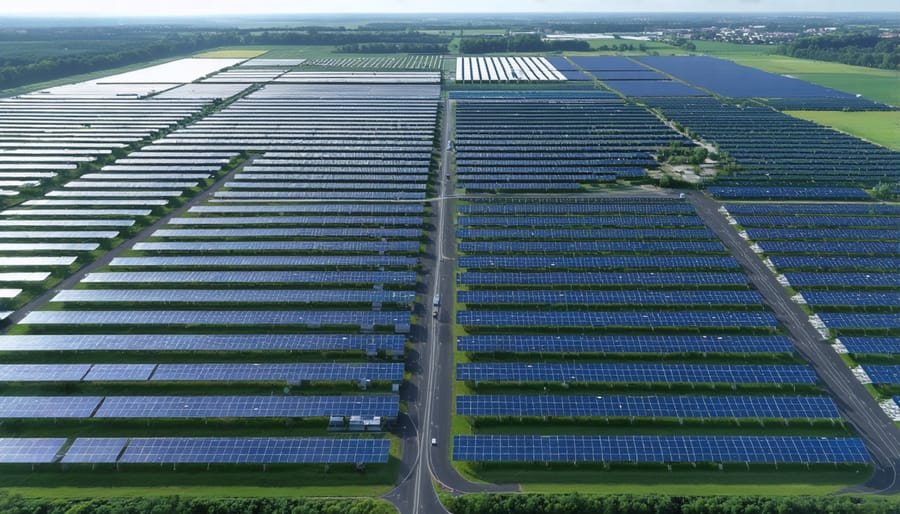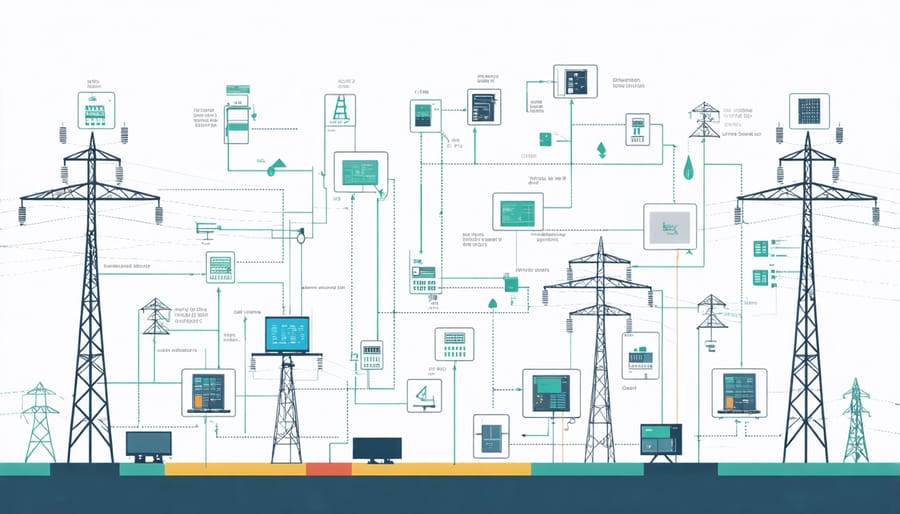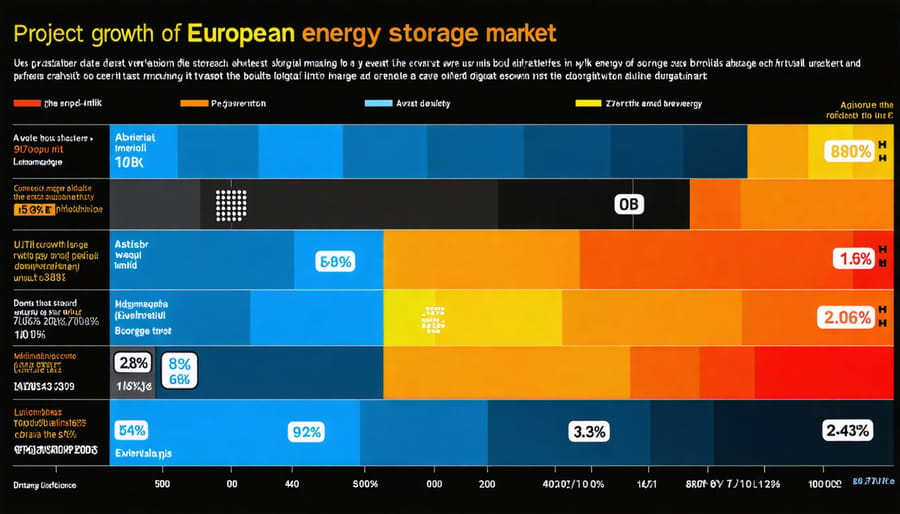How European Grid-Scale Storage Companies Are Revolutionizing Solar Energy

Grid-scale energy storage stands at the forefront of Europe’s renewable energy revolution, transforming how nations manage and distribute power across vast networks. As renewable energy sources continue to replace traditional fossil fuels, sophisticated storage solutions have become critical infrastructure investments, enabling grid operators to balance supply and demand with unprecedented precision.
Leading companies in this sector are developing innovative technologies that extend far beyond traditional battery systems. From advanced compressed air facilities in Germany to cutting-edge hydrogen storage projects in Denmark, these enterprises are pioneering solutions that operate at scales previously thought impossible. Their technologies not only ensure grid stability during peak demand but also enable the integration of intermittent renewable energy sources into existing power networks.
The market for grid-scale storage is experiencing exponential growth, with European investments expected to exceed €50 billion by 2030. This surge is driven by ambitious climate targets, declining technology costs, and increasing demand for reliable renewable energy integration. Industry leaders are now focusing on developing storage systems that combine multiple technologies – from flow batteries to gravitational storage – creating hybrid solutions that maximize efficiency while minimizing environmental impact.
For grid operators, utilities, and energy investors, understanding the landscape of grid-scale storage companies has become essential for making informed infrastructure decisions that will shape Europe’s energy future.
The Evolution of Grid-Scale Storage Technology

Key Storage Technologies
The landscape of energy storage technologies for grid-scale applications is dominated by several key solutions, each offering distinct advantages. Lithium-ion batteries remain the most widely deployed option, thanks to their proven reliability, high energy density, and rapidly declining costs. These systems excel in providing short-duration storage and frequency regulation services.
Flow batteries represent another significant technology, particularly valuable for their scalability and longer duration storage capabilities. Unlike lithium-ion systems, flow batteries can decouple power from energy capacity, making them highly adaptable for various grid applications. Vanadium redox and zinc-bromine variants are gaining traction in European markets.
Emerging alternatives include compressed air energy storage (CAES), which utilizes underground caverns to store energy, and gravity-based systems that leverage height differences to store potential energy. Advanced thermal storage solutions, using molten salt or phase-change materials, are also showing promise for grid-scale applications, particularly when integrated with renewable energy sources.
Each technology addresses specific grid requirements, from rapid response capabilities to long-duration storage needs, contributing to a more resilient and flexible power infrastructure.
European Market Leaders
Several European companies are leading the charge in grid-scale energy storage innovation, shaping the future of renewable energy integration. According to recent European market analysis, firms like Northvolt (Sweden) and Fluence Energy (Germany) are pioneering advanced battery technologies and intelligent storage solutions.
France-based Saft, a subsidiary of Total, has established itself as a frontrunner in industrial-scale battery systems, particularly in island grids and remote locations. Their lithium-ion technology has proven crucial for grid stabilization across multiple European territories.
In the United Kingdom, Zenobe Energy has made significant strides in battery storage deployment, managing over 1.6 GWh of operational assets. Their innovative business model combines storage solutions with electric vehicle fleet support, showcasing the versatility of grid-scale storage applications.
Swiss-based Leclanché has emerged as a key player in both stationary storage and e-transport solutions, with their proprietary cell technology enabling longer battery life and enhanced safety features. These companies continue to drive sustainability initiatives while maintaining Europe’s position at the forefront of energy storage innovation.
Industrial Applications and Case Studies
Manufacturing Sector Integration
The manufacturing sector is increasingly embracing grid-scale energy storage as a cornerstone of industrial energy independence and operational efficiency. Major European manufacturers, particularly in energy-intensive industries like steel production and chemical processing, are integrating large-scale storage solutions to optimize their power consumption patterns and reduce peak demand charges.
Companies are implementing hybrid systems that combine battery storage with renewable energy installations, enabling them to maintain consistent production schedules while reducing their carbon footprint. For instance, several automotive manufacturers in Germany have deployed megawatt-scale battery systems to balance their energy needs and support their commitment to sustainability goals.
The integration of storage systems helps manufacturing facilities manage power quality issues, providing stable voltage and frequency support crucial for sensitive manufacturing equipment. This approach has proven particularly valuable in regions with variable grid reliability, where uninterrupted power supply is essential for maintaining production schedules.
Furthermore, these storage installations are being leveraged for demand response programs, allowing manufacturers to participate in grid services while generating additional revenue streams. This dual-purpose approach has demonstrated that storage systems can serve both operational reliability and economic objectives, making them increasingly attractive to industrial energy users across Europe.
Utility-Scale Projects
Several landmark utility-scale energy storage projects across Europe demonstrate the growing momentum of grid-scale solutions. In Germany, the WEMAG Battery Park in Schwerin showcases a 10-megawatt lithium-ion installation that provides grid stability services and frequency regulation. This pioneering project has been operational since 2014 and continues to serve as a model for large-scale storage integration.
The UK hosts multiple innovative implementations, including the 50MW Pelham Storage Project in Hertfordshire, which combines battery storage with sophisticated energy management systems to support grid balancing. In Ireland, the Kilroot Power Station features a 10MW energy storage array that helps manage wind power integration and provides essential grid services.
Spain’s Almacena Project in Carmona demonstrates how utility-scale storage can enhance renewable energy integration in southern Europe. The 1MW/3MWh installation specifically addresses challenges related to solar power fluctuations and grid stability.
In the Netherlands, the Amsterdam Energy ArenA showcases how large-scale storage can serve multiple purposes. Its 3MW system not only provides backup power for the stadium but also participates in grid balancing services for the local network.
These projects highlight how utility-scale storage solutions are becoming increasingly vital for European grid infrastructure, supporting the transition to renewable energy while maintaining grid stability and reliability.
Technical Considerations and Implementation
System Integration
Integrating large-scale energy storage systems into existing grid infrastructure requires careful planning and sophisticated technical solutions. The process begins with detailed grid impact assessments to evaluate the local network’s capacity and identify potential connection points. Modern storage systems employ advanced power electronics and control systems to ensure seamless integration with the grid while maintaining stability and power quality.
Key to successful integration is the implementation of smart inverter technology, which enables bi-directional power flow and provides essential grid services such as frequency regulation and voltage support. These systems must comply with strict grid codes and interconnection standards, including the European Network Codes and country-specific requirements.
Grid operators utilise advanced energy management systems (EMS) to coordinate storage operations with other grid assets. These systems optimise charging and discharging cycles based on real-time grid conditions, demand patterns, and energy prices. Modern integration solutions also incorporate cybersecurity measures to protect against potential threats and ensure reliable operation.
The physical connection typically involves installation of transformers, switchgear, and protection equipment. Companies must also implement sophisticated monitoring and control systems that enable remote operation and real-time performance analysis. These systems often feature redundant communication channels to ensure continuous grid connectivity.
For optimal performance, integration projects require careful consideration of factors such as response time, ramp rates, and power quality requirements. Advanced forecasting tools help predict grid conditions and storage needs, while automated control systems ensure efficient operation within safe operating parameters. The integration process often includes extensive testing and commissioning phases to verify system functionality and compliance with grid requirements.

Performance Optimization
Maximising the efficiency and longevity of grid-scale energy storage systems requires a sophisticated approach to performance optimization. Leading storage companies employ advanced monitoring systems that track key performance indicators in real-time, allowing for predictive maintenance and swift response to potential issues.
Temperature management plays a crucial role in system optimization. Modern storage facilities utilize intelligent cooling systems and thermal management technologies to maintain optimal operating conditions, significantly extending battery life and maintaining peak efficiency. This is particularly relevant in European climates, where seasonal temperature variations can impact storage performance.
Energy management software represents another cornerstone of performance optimization. These sophisticated platforms use artificial intelligence and machine learning algorithms to optimize charging and discharging cycles, reducing degradation while maximizing energy throughput. Companies increasingly integrate weather forecasting data to anticipate renewable energy generation patterns and adjust storage strategies accordingly.
Regular maintenance protocols, including systematic component testing and replacement schedules, ensure consistent performance levels. Leading storage providers implement automated diagnostic systems that can identify potential failures before they occur, minimizing downtime and maintaining grid reliability.
Performance optimization also extends to system scalability. Modern storage installations are designed with modularity in mind, allowing for capacity expansion without compromising existing system efficiency. This approach enables businesses to start with smaller installations and scale up as needed, maintaining optimal performance throughout the system’s lifecycle.
Energy storage companies are increasingly focusing on end-of-life management and circular economy principles. By implementing sophisticated recycling programs and designing systems for easy component replacement, they ensure sustainable operation while maximizing the overall return on investment for storage installations.
Future Outlook and Innovation
Emerging Technologies
The landscape of grid-scale energy storage is evolving rapidly, with several advanced storage solutions showing remarkable promise. Flow batteries are gaining traction, particularly vanadium redox flow systems, which offer exceptional scalability and longer operational lifespans compared to traditional lithium-ion batteries. These systems are particularly well-suited for European utility-scale applications, where long-duration storage is increasingly vital.
Solid-state batteries represent another breakthrough technology, with European researchers making significant strides in developing more stable and energy-dense storage solutions. These batteries promise enhanced safety features and improved performance in varying temperature conditions, crucial for grid-scale applications across diverse European climates.
Thermal energy storage systems utilizing molten salt technology are also emerging as viable options, especially when integrated with concentrated solar power plants. This technology has shown particular promise in Southern European regions, where solar resources are abundant.
Hydrogen storage systems, while still in early stages, are demonstrating potential for seasonal energy storage. Several pilot projects across Europe are exploring power-to-gas technology, converting excess renewable energy into hydrogen for long-term storage. This approach could prove instrumental in addressing seasonal supply-demand mismatches in the grid system.
Gravity-based storage solutions, using innovative mechanical systems to store energy through elevation differences, are also gaining attention for their simplicity and durability.

Market Projections
The European grid-scale energy storage market is poised for remarkable growth, with projections indicating a compound annual growth rate (CAGR) of 15.7% between 2023 and 2030. This expansion is primarily driven by the increasing integration of renewable energy sources and the pressing need for grid stability across the continent.
Industry analysts forecast that the European market value for grid-scale storage solutions will surpass €12 billion by 2030, with particular growth hotspots in Germany, France, and the Nordic regions. The implementation of the European Green Deal and national energy transition policies continues to create favorable conditions for large-scale storage deployment.
Key growth drivers include the rapid expansion of wind and solar installations, aging grid infrastructure requiring modernisation, and increasing demand for grid flexibility. The market is expected to see significant investment in both lithium-ion and emerging storage technologies, with utility-scale batteries becoming increasingly cost-competitive.
Opportunities are particularly robust in regions with high renewable energy penetration, where grid-scale storage can provide essential services such as frequency regulation and peak shaving. The industrial sector is projected to be a major beneficiary, with manufacturing facilities increasingly adopting storage solutions to manage energy costs and ensure reliable power supply.
Recent policy developments, including the EU’s REPowerEU initiative, are expected to accelerate market growth by providing additional funding and regulatory support for energy storage projects.
Grid-scale energy storage stands as a cornerstone of Europe’s transition to sustainable energy systems. As our continent moves decisively towards renewable energy sources, the importance of efficient and reliable storage solutions cannot be overstated. These technologies are proving instrumental in addressing the intermittency challenges of renewable energy, ensuring grid stability, and enabling a more resilient power infrastructure.
The rapid advancement of storage technologies, coupled with declining costs and increasing efficiency, positions Europe at the forefront of the global energy transformation. Companies specialising in grid-scale storage are not just providing technical solutions; they are actively shaping the future of energy distribution and consumption across the continent.
Looking ahead, the role of grid-scale storage will become even more crucial as European nations work towards their ambitious climate goals. The technology enables better integration of renewable energy sources, supports grid balancing, and provides essential backup power during peak demand periods. This infrastructure is vital for maintaining energy security while reducing dependence on fossil fuels.
For European businesses and communities, the expansion of grid-scale storage represents an opportunity to participate in a more sustainable and economically viable energy future. As we continue to witness innovations in this sector, the collaboration between storage companies, utilities, and end-users will be essential in creating a more resilient and environmentally responsible energy landscape.
Leave a Reply